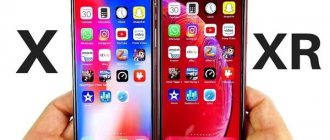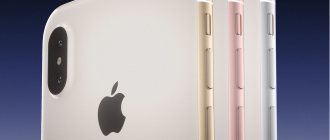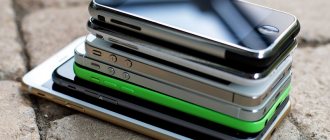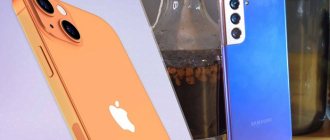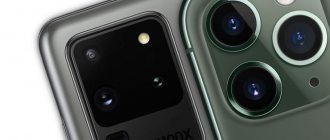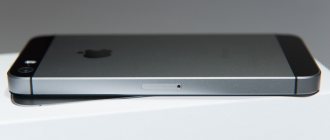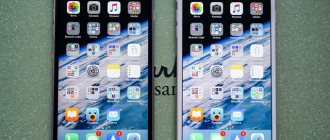Once again, in mid-September, we are witnessing a parade of iPhones across the planet. Even now, at the very start of sales, we can say with confidence that the “Seven” will become a landmark device. It sets a new standard in mobile device design.
What interesting things does Apple offer us in the next flagship, and how does it actually differ from its predecessors?
Exterior + functionality
There is practically nothing to complain about in the design of the new model - the protruding chamber was equipped with a neat sealing ring that ensures water resistance, the ill-fated antenna strips were made less noticeable by moving them closer to the ends, the Home button was “hidden” under glass. As a result, the gadget looks completely monolithic, and, in fact, it is.
As experts predicted, the iPhone has finally become airtight!
The highest quality of assembly of the “sevens” is noteworthy - there are absolutely no backlashes or “crunching” buttons, as in the pilot versions of the “sixes”.
The most important button, Home, has also received an update. Instead of mechanical, it became sensory. And to facilitate communication with an intangible button, engineers replaced the former mini-jack connector with an improved TapticEngine engine.
Depending on the force of pressing, it generates vibrations of varying intensity, based on which the user feels the response of the system. According to those who have tried it, you get used to it quickly, and in the future, “communication” with the button is intuitive.
In addition, the introduction of a touch button means eliminating at least half of the reasons for users to contact service centers. After all, it was not just a button, but also a “central lock” with a unique serial number, which could not be simply replaced without losing the lion’s share of functionality. Most often, in case of breakdowns, Home had to replace the gadget with a new one - at an additional cost. Or be content with the limited capabilities of the “donor”.
This innovation made it possible to make the iPhone 7 airtight, since there were simply two fewer holes (a 3.5 mm port and a recess for the Home button). But there is also a negative point in this - in winter, if you are wearing gloves, you will not be able to unlock your smartphone.
Software
With the release of each new version of iOS, the Internet is filled with complaints about how the latest update works. I don’t know how 10 behaves on older iPhones, but I want to add my two cents about the software on the new smartphone.
For the most part everything works well. I caught one rather criminal glitch during the installation of programs from the App Store. I haven’t been to the store for a long time, and during this time the security policy was updated, which I should have read before downloading anything.
The store redirected me to a page to familiarize myself with the new rules, but the “Accept” button still did not appear.
At first nothing worked at all, not even the “Send to e-mail” link, but after about four reboots the App Store finally started working.
I also had a little lag when scrolling through the list of TOP applications in the official store.
You scroll down, and the list begins to twitch nervously. You flip through again - everything is in order.
These are the few quirks that I was able to discover. Otherwise, everything is in perfect order and everything works great. If anything, version iOS 10.0.
I won’t speak for all places in the interface, but I tried to check most possible situations.
Dimensions
As for the sizes of the new flagships, they remain the same as their predecessors. The only difference is that the total weight of the devices has changed a little. They are a few grams lighter than the 6 S, but still not as light as the first-generation 6s.
At first glance, the difference in the dimensions of the smartphones is minimal, and, in theory, cases from both versions of the sixes could be suitable for the new flagship. However, there is a small nuance - in the 4.7-inch modification, the manufacturer has moved the camera socket closer to the ends, and the “eye” itself with the lens has become larger. Thus, it turns out that part of the camera will simply be covered with a cover.
And for the plus version, even more so, the non-standard dual module of two cameras forces you to purchase a new case.
Upgrading from iPhone 6 to iPhone 7 is worth considering!
The new camera in iPhone 7 is equipped with optical image stabilization.
Going from the iPhone 6 (without the "S" in the name) to the iPhone 7 seems to make a little more sense. After all, the iPhone 6 has been on sale for two years. The biggest differences are, of course, in the display technology: the iPhone 6's screen doesn't have the pressure sensitivity that Force Touch provides. This feature first appeared only in the iPhone 6S and, of course, the iPhone 7 also has it.
Another big difference between the smartphones is the camera parameters - the 8-megapixel module no longer meets modern requirements for top-end phones. Of course, system performance and battery characteristics will vary significantly. Only our full laboratory tests will show how big the difference between these devices will be.
Tightness
As already mentioned, the “seven” became waterproof, something both predecessors could not boast of. A special adhesive tape is laid under all the joints of the case, making the smartphone airtight. I wonder if it will be possible to restore it in the event of any service intervention? Or will the iPhone still let moisture in after opening it?
Please note that the “seventh” iPhone is not intended for long swims with the owner.
The protection of the gadget is rather designed for short-term exposure to the aquatic environment. In this case, everything will work out without consequences. The maximum that the new iPhone can withstand is a half-hour stay in fresh (!) water, and at a depth of no more than one meter.
In addition to water, the seven will also be reliably protected from dust getting under the body - this is what the manufacturer’s declared tightness level suggests - IP 67.
It would not be amiss to cite a very interesting fact - even sealed “sevens”, somehow drowned by users, are not subject to service. Those. The presence of moisture under the housing cover is grounds for refusal to repair or replace them free of charge. Therefore, we do not recommend experimenting too much with immersing your smartphone in water to “test its strength.”
Battery life
1960 mAh is the capacity of the battery installed in the device. The Plus version accommodates a more capacious battery - 2900 mAh.
In the previous generation (6S), a 1715 mAh battery was installed, and a year earlier the iPhone could boast a 1820 mAh battery. Now there has been a breakthrough and the new product works two hours longer. According to the manufacturer, of course. And besides, there is the following official data:
- 14 hours of Internet surfing via Wi-Fi
- 12 Internet via 3G or 4G networks
- 13 hours of wireless video playback
- 10 days standby time (how?!)
And now about personal impressions. I fully charged the device at 12 noon. At one o'clock in the morning it was already almost completely discharged - 12 percent remained. During this time, I drove the smartphone into its tail and mane, so the term “intensive use” suits this situation perfectly.
With more relaxed use, you should expect to work for one day, but no more. The rule of putting the phone on charge when we straighten out the bed for sleep will haunt us for a long time.
I am very confused by the fact that the device takes a very long time to charge - it took my copy about two and a bit hours to reach 100 from 12 percent. These are indicators that are already far behind the market, because competitors are not asleep and charge 100 percent in an hour and a half, or even less. Let's remember the same OnePlus 3, which needs only 1 hour and 10 minutes to reach full capacity.
New sound
The creators also did a good job on the sound quality of the iPhone. Instead of a separate audio jack, another external speaker was added, and the iPhone acquired powerful stereo sound. The difference between the models is clearly noticeable, even to very demanding ears.
But the most important thing is that Apple left only one lightning for connecting the iPhone with other devices: headphones, charger, computer.
Therefore, the new configuration will include headphones with a lightning connector. Also, in order to relieve the load on the single port, the company also introduced a wireless headset – AirPods.
The main disadvantage of wireless data transmission has always been the inevitable lag between the audio track and the image on the screen. Apple claims that with the help of the revolutionary AirPods it managed to overcome this unpleasant feature.
The second controversial point is the limited battery life of wireless systems. When pairing, the charge of both the smartphone itself and the headset used is consumed. But here, too, the company assures that there will be no problems - you are guaranteed up to 5 hours of battery life, and another 3 hours during the day after a 15-minute recharge from the case.
Both of these factors are the reason for the so far extremely low penetration of wireless systems - there are too many limiting points. But, as we see, Apple is once again breaking stereotypes.
conclusions
We did not compare all parameters with each other, but only the main ones. According to these parameters, the iPhone 7 turned out to be better with 10 likes, while the iPhone 6 had 3. The final table, for which we gave likes:
| iPhone 7 | iPhone 6 |
|
|
Memory capacity
Another global update affected the amount of built-in memory. The long-standing “16/64/128” line has been replaced by 32/128/256 gigabyte versions. In addition, from now on, the closest predecessor versions will also receive “new memory”.
It is noteworthy that the manufacturer doubled the capacity without increasing the overall cost of smartphones, in either case.
It is not yet known how such increases will affect the performance of devices, since predecessors with 128 GB of memory on board previously had problems with stability.
iPhone 6 copy: What is the difference?
There are a huge number of low-quality imitations of Apple technology on the market. It is important to know how to distinguish an iPhone 6 from a fake. First of all, pay attention to the cost of the phone. If it is too low, then there is a reason to study the gadget in more detail and play it safe.
We will tell you how to distinguish an iPhone 6 from a fake. The first thing to do is check the serial number. To do this, you need to enter the gadget settings. Many people don’t know how to distinguish iPhone 6 from its Chinese counterpart. It's quite simple. You need to log into the manufacturer’s portal and enter the gadget number. You will receive all the data about the phone if you have the original and not a copy.
To avoid getting into trouble, you need to know exactly how the Chinese iPhone 6 differs from the original. First of all, pay attention to the operating system. Original Apple phones run exclusively on iOS. If you saw “Android”, this is an obvious fake.
Also pay attention to the appearance of the device. There should not be any additional markings in the form of hieroglyphs or anything like that. Now you know how to distinguish iPhone 6 from cheap fakes. This information will be useful to you when buying a smartphone.
Cameras
Improvements have also been made to camera modules. They even outwardly became more massive and better built, or something. See for yourself, here's how they compare to the 6 S.
The selfie camera now has a resolution of 7 megapixels (versus 5 megapixels in the 6S or a ridiculous 1.2 megapixels in the “six”). The resolution of the main camera remains exactly the same as that of the 6S (i.e. 12 megapixels), but the hardware has undergone significant improvements.
Cameras have become even more effective at suppressing any interference, better recognizing faces and figures, and the color range has expanded significantly. The plus version even received a dual wide-angle lens, which can even be used to shoot movies. The 7 Plus also adds 10x zoom capability.
Finally, the “younger” version of iPhones has received advanced optical image stabilization. Photos and videos are amazingly clear, even when shooting in motion. Now iPhones have a built-in bright 4-diode flash, instead of the 2-diode flash of their predecessors, which means the quality of night photography will also be high.
On top of everything, a lot of hardware and software for image processing was added. It also became possible to edit the “picture” directly during shooting. In general, the seven can only be taken for a cool camera.
Design
In terms of design, nothing has changed dramatically since the release of the sixth model, and if you look at the outside of the 6th and 7th iPhones, you might be surprised at how similar they are. Absolutely everything is in the same places. Only the seventh no longer has a headphone jack as such. In this case, iPhone 6 will be more interesting for some.
In the seventh generation, the mechanism of the “Home” button was changed, which lost the pressing mechanism and became completely touch-sensitive. Which is not always good and sometimes adds a lot of problems to its owner.
Comparison of the cost of models 6S 32Gb and 7 32Gb
- Screen diagonal: 4.7 inches
- Screen resolution: 1334×750
- Weight: 143 g
- Number of SIM cards: 1
- Processor: Apple A9
- Memory capacity: 32 GB
- RAM capacity: 2 GB
- Battery capacity: 1715 mAh
- Camera: 12 MP
- Memory card support: no
- Support for 4G networks: yes
- Screen diagonal: 4.7 inches
- Screen resolution: 1334×750
- Weight: 138 g
- Number of SIM cards: 1
- Processor: Apple A10 Fusion
- Memory capacity: 32 GB
- RAM capacity: 2 GB
- Battery capacity: 1960 mAh
- Camera: 12 MP
- Memory card support: no
- Support for 4G networks: yes


